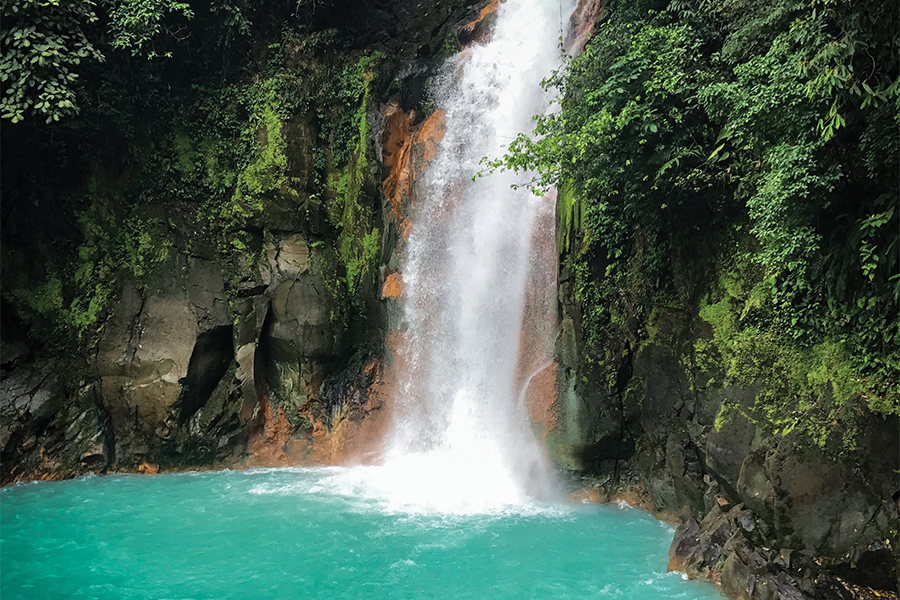7 Reasons to Visit Costa Rica (And Travel Tips to Help You Plan)

From bird watching and white-water rafting to surf beaches to volcano hikes, Costa Rica’s eco-adventure scene is in a class all its own. The lush, tropical Central American country also offers quiet moments of soul-soothing joy, courtesy of Mother Earth. Read on for more reasons to make Costa Rica your next vacation.
1. Bucket-List Costa Rica Adventure
Tropical rain forests, jungle and over 800 miles of coastline along the Pacific Ocean and Caribbean make up Costa Rica’s eco-adventure playground. Soft adventure has massive appeal for its range of possibilities, with something for everyone—from early morning bird-watching tours to hot spring baths, butterfly and coffee farms, and panoramic views from “hanging bridges” that traverse the forest canopy. For thrill-seekers, there is white-water rafting, volcano and rainforest hikes, zip-lining and “canyoning,” which can include rappelling over (and swimming beneath) waterfalls, rock climbing and narrow canyon treks.
Travel Tip
Eco-adventure activities require advance planning because capacity at most settings is limited. In fact, some National Parks take reservations, selling out weeks in advance. To avoid this, reserve and prepay accommodations and activities in one package with your AAA Travel Advisor. You’ll have one point of contact and an itinerary that includes reservation details along with a packing list. Tour guides will arrive at your hotel with your name on their manifest, and off you go.
2. Abundant Wildlife
One of the most biodiverse places on Earth, Costa Rica inhabits just .03% of the planet’s surface—but it is home to 5% of the world’s animal and plant species. In fact, Costa Rica boasts 12 vibrant ecosystems, 25% of which are protected as wildlife reserves, refuges and National Parks. It’s partly a result of earthquakes and volcanic eruptions millions of years ago that fused the North and South American continents, creating a land bridge that is now Costa Rica and Panama. Birds, insects, marine animals, and other wildlife came from both directions, settling in various habitats, from dense, forested mountains to mangrove swamps, dry lowlands and the wet coastal plains of the Caribbean.
Visitors find themselves awed by nature’s splendor. The sight of a mama sloth cradling her baby in the crook of a tree, spider monkeys swinging between treetops, or even a tiny, red-eyed tree frog clinging to a leaf reminds us that on this planet, sometimes we’re just the humble bystanders.
Birds in Costa Rica
If you aren’t a bird enthusiast before you travel to Costa Rica, you might become one. There are more than 900 bird species throughout the country—about 600 are residents, and the rest are migratory, mostly from North America. Among many sought-after sightings: the brightly colored Scarlett Macaw (one of the world’s largest parrots), the elusive brilliant-green Resplendent Quetzal, and all varieties of Motmots, a woodland bird with colorful plumage and a heavy bill.
Travel Tip
Pack a pair of binoculars—you will use them often, especially on a bird-watching tour or nature walk. Photographing the colorful birds is challenging but worth the effort. Just like at home, they build nests in hard-to-find places, they perch high in the treetops, and of course, they fly. But when your lens captures hummingbirds fluttering in their nest, a toucan soaring overhead, or a tiny blue-gray tanager perched on a narrow twig, it takes your breath away.
Marine Life
Scuba divers, snorkelers and catamaran sailors explore Costa Rica’s coastlines year-round, searching for tropical fish, rays, sharks and dolphins that thrive in the warm ocean waters. Shyer creatures, like sea turtles and manatees, are best viewed on organized excursions, like kayak trips through mangroves in the western Guanacaste region or the OSA Peninsula on the southern Pacific coast.
Whale watchers might have their best luck on Costa Rica’s Pacific side, especially from December through April when the northern hemisphere humpback species migrate south, or July to November when southern antarctic species come in large groups to give birth. On the Caribbean side, North Atlantic humpbacks can be spotted near the Tortuguero National Park between December and March.
Travel Tip
Costa Rica is home to five endangered species of sea turtles. Witnessing the nesting and hatching process of these creatures is one of Costa Rica’s most popular eco-adventure activities, but most sites are only accessible through regulated access points. One of your best bets for in-depth turtle exploration is Tortuguero National Park, a 77,000-acre conservation area on the Caribbean coast. Look for companies that adhere to strict sustainability practices, like Tortuguero Eco Experiences (tortugueroecoexperiences.com) for small groups and expert guides.
3. Transportation in Costa Rica Made Easy
Driving in Costa Rica is not for the faint of heart. Many roads offer stunning scenery, but most are two-lane, and some are rugged and pot-holed, which can mean treacherous driving at night and in the autumn rainy season. Driving times can be surprisingly long, too. For example, it’s only about 80 miles between the San Jose airport and La Fortuna, near Arenal Volcano—but it’s a three- to four-hour journey, depending on the route and traffic conditions.
Rental cars offer flexibility, it’s true. But AAA Travel Advisors recommend the alternative if possible: booking airport transfers to the hotel and supplementing your trip with activities, which always include transportation. AAA advisors can also arrange affordable shared and private transfer service throughout the country, operated by companies with experienced, English-speaking drivers who can anticipate road hazards and other delays. They’ll also break for meals, rest stops, scenic overlooks and points of interest.
Travel Tip
Consider a guided vacation in a comfortable, eco-friendly motorcoach that includes everything from accommodations to meals and sight-seeing in one neat package. Many are family friendly.
4. Bountiful Fruit
For those of us who pay a small fortune for tiny containers of berries and wait all year for three weeks of perfectly ripe peaches, Costa Rica’s abundant fruit selection is a vacation highlight. Roadside stands and breakfast buffets are overflowing with sweet watermelon, papaya, guava and other delightful discoveries like star fruit, Malay apples and the seeds of granadilla (sweet passion fruit).
A typical snack is a super-sweet pineapple boat sliced into bite-size wedges or a plate of sliced, ripe mango. And the ubiquitous mealtime side dish comes from a plantain, the oversize starchy banana-like fruit you might see in your local grocery store. Platanos Maduros, or Costa Rican fried plantains, are prepared by lightly frying the ripened fruit with butter, cinnamon, brown sugar and vanilla until it’s soft and sweet. It’s a delicious dessert but is usually served with a meal of rice, beans and a protein, like pork or chicken.
Travel Tip
Be sure to include breakfast with your hotel or resort stay, and sample everything. This is fresh-picked fruit at its tastiest.
5. Fabulous Flora
Costa Rica’s ecosystem is a near-perfect bubble of life for some of the world’s most exquisite flowers, including over 1,000 species of orchids. These brightly colored, delicate plants are amazingly versatile—growing on trees, around rocks and in the ground, thriving best in the moist soil and cooler temperatures of cloud forests at higher elevation.
Many ornamental flowers—like the showy Red Gingers and Bird of Paradise—have been imported from tropical regions in Southeast Asia, India and the Caribbean.They’ve adapted to the landscape and flourish along with 9,000-plus species of native flora that enhance Costa Rica’s natural beauty.
Travel Tip
Over 450 orchid species are exhibited in Montverde’s Orchid Garden, located in Santa Elena, in the country’s central region. More than 120 of these flowers are in bloom every day of the year. The entrance fee includes a 45-minute guided tour, so you can learn about wild orchids, hybrids and how to care for them. (The drive to Montverde is stunning, too).
6. Local Costa Rica Tour Guides
Cosa Rica’s eco-adventure activities are managed by companies staffed with local experts. Whether they’re zip-lining guides or certified wildlife experts, they’re invested in your enjoyment, enrichment, and most of all, your safety. You’ll typically meet up at your hotel or resort and travel together to an activity location. In some cases—Manuel Antonio National Park, for example—the entry point may be just steps away.
Travel Tip
To make the most of your time in Costa Rica’s natural parks or wildlife refuges, arrange for a guide with the help of your AAA travel advisor. They are the teachers, armed with telescopes for shared viewing, field guides and vast knowledge of flora and fauna. They also share what they’re seeing with one another, so there might be whispers and waves as one hears the call of a Resplendent Quetzal or another spots a snake camouflaged on a distant tree branch. They’re just as excited as you are. And book private tours, so you’re the only ones looking through the telescope. It doesn’t cost much more, and you’ll have your guide’s undivided attention.
7. Stellar Beaches in Costa Rica
With a little planning, you can arrange your vacation around adventure, plus the perfect secluded hideaways. Costa Rica boasts a breathtaking array of beach options, from broad stretches of sugary white sand and boogie-board friendly waves to sheltered coves framed by swaying palm trees. Sunsets over a sparkling blue ocean? They’ll be imprinted in your memory forever.
Travel Tip
Vacationers on the popular Pacific Coast give high marks for Playa Conchal, 10 miles from the beach town of Tamarindo on the northern reaches of the Guanacaste region. Winding 2.5 miles around a bay, it’s protected from high winds and strong currents, and its white crushed seashell beach is picture perfect.





